Ultrananocrystalline Diamond Nanowires: Fabrication, Characterization, and Sensor Applications
Abstract
:1. Introduction
2. UNCD Synthesis and NW Fabrications
2.1. Synthesis of UNCD Films
2.2. UNCD Doping Techniques
2.3. Electron-Beam Lithography (EBL) and Inductively Coupled Plasma Reactive Ion Etching (ICP-RIE)
2.4. EBL-ICP-RIE-Based UNCD NW Fabrications
2.4.1. Top-Down Fabrication Technique of UNCD Nanostructures
2.4.2. Bottom-Up Fabrication Technique of UNCD Nanostructures
3. Characterizations of UNCD NWs
3.1. Structural Properties of UNCD NWs
3.2. Electrical Properties of UNCD NWs
4. UNCD NW Sensor Applications
4.1. Gas Sensors
4.1.1. CH4 Gas Sensors
4.1.2. CO Gas Sensors
4.2. UV Photodetectors
4.3. Piezoresistance (PZR) Effect-Based Sensors
4.4. Biosensors and Nitrogen-Vacancy Quantum Sensors
5. Discussion and Outlook
6. Conclusions
Author Contributions
Funding
Institutional Review Board Statement
Informed Consent Statement
Data Availability Statement
Acknowledgments
Conflicts of Interest
Abbreviations
| AFM | atomic force microscopy |
| BOE | buffered oxide etch |
| B-UNCD | boron-doped ultrananocrystalline diamond |
| CPD | critical point drying |
| CVD | chemical vapor deposition |
| DI | deionized |
| DNA | deoxyribonucleic acid |
| DNP | diamond nanoparticle |
| DNW | diamond nanowire |
| EBL | electron-beam lithography |
| EDS | energy-dispersive X-ray spectroscopy |
| EELS | electron energy loss spectroscopy |
| FEA | finite element analysis |
| FESEM | field emission scanning electron microscopy |
| FE | field emission |
| FIB | focused ion beam |
| FWHM | full width at half maximum |
| HFCVD | hot-filament chemical vapor deposition |
| HRSEM | high-resolution scanning electron microscopy |
| HRTEM | high-resolution transmission electron microscopy |
| HSQ | hydrogen silsesquioxane |
| ICP | inductively coupled plasma |
| IR | infrared |
| LER | line edge roughness |
| MCD | microcrystalline diamond |
| MIBK | methyl isobutyl ketone |
| MPCVD | microwave plasma chemical vapor deposition |
| MSM | metal–semiconductor–metal |
| NCD | nanocrystalline diamond |
| ND | nanodiamond |
| NEMS | nano-electro-mechanical systems |
| NEXAFS | near-edge X-ray absorption fine structure |
| NMR | nuclear magnetic resonance |
| NP | nanoparticle |
| NR | nanorod |
| NT | nanotube |
| N-UNCD | nitrogen-doped ultrananocrystalline diamond |
| NV | nitrogen-vacancy |
| NW | nanowire |
| NWA | nanowire array |
| PCD | polycrystalline diamond |
| PD | photodetector |
| ppm | parts per million |
| PZR | piezoresistivity/piezoresistance |
| QIT | quantum information technology |
| RF | radio frequency |
| RFCVD | radio frequency chemical vapor deposition |
| RIE | reactive ion etching |
| RMS | root-mean-square |
| RT | room temperature |
| RTP | a rapid thermal processor |
| SAED | selected area electron diffraction |
| sccm | cm³/min in standard conditions for temperature and pressure (a unit of mass flow rate) |
| SCD | single-crystal diamond |
| SCL | space-charge-limited |
| SEM | scanning electron microscopy |
| SIMS | secondary ion mass spectrometer |
| S-MCD | sulfur-doped microcrystalline diamond |
| S-NCD | sulfur-doped nanocrystalline diamond |
| SOD | spin-on-dopant |
| S-SMCD | sulfur-doped sub-microcrystalline diamond |
| STM | scanning tunnel microscopy |
| TEM | transmission electron microscopy |
| TLM | transmission line measurement |
| TMB | trimethyl borane |
| UHV | ultra-high vacuum |
| UNCD | ultrananocrystalline diamond |
| UV | ultraviolet |
| W | tungsten |
| WLI | white light interferometer |
| XRD | X-ray diffraction |
References
- Eversole, W.G. Synthesis of Diamond. US Patent 3,030,187, 17 January 1962. [Google Scholar]
- Spitsyn, B.V.; Bouilov, L.L.; Derjaguin, B.V. Vapor growth of diamond on diamond and other surfaces. J. Cryst. Growth 1981, 52, 219–226. [Google Scholar] [CrossRef]
- Butler, J.E.; Windischmann, H. Developments in CVD-diamond synthesis during the past decade. MRS Bull. 1998, 23, 22–27. [Google Scholar] [CrossRef]
- Ong, T.P.; Chiou, W.A.; Chen, F.R.; Chang, R.P.H. Preparation of nanocrystalline diamond films for optical coating applications using a pulsed microwave plasma CVD method. Carbon 1990, 28, 799. [Google Scholar] [CrossRef]
- Birrell, J.; Gerbi, J.E.; Auciello, O.; Gibson, J.M.; Johnson, J.; Carlisle, J.A. Interpretation of the Raman spectra of ultrananocrystalline diamond. Diam. Relat. Mater. 2005, 14, 86–92. [Google Scholar] [CrossRef]
- Gruen, D.M. Ultrananocrystalline diamond in the laboratory and the Cosmos. MRS Bull. 2001, 26, 771–776. [Google Scholar] [CrossRef]
- Jiao, S.; Sumant, A.V.; Kirk, M.A.; Gruen, D.M.; Krauss, A.R.; Auciello, O. Microstructure of ultranocrystalline diamond films grown by microwave Ar-CH4 plasma chemical vapor deposition with or without added H2. J. Appl. Phys. 2001, 90, 118. [Google Scholar] [CrossRef]
- Fuentes-Fernandez, E.M.A.; Alcantar-Peña, J.J.; Lee, G.; Boulom, A.; Phan, H.; Smith, B.; Nguyen, T.; Sahoo, S.; Ruiz-Zepeda, F.; Arellano-Jimenez, M.J.; et al. Synthesis and characterization of microcrystalline diamond to ultrananocrystalline diamond films via Hot Filament Chemical Vapor Deposition for scaling to large area applications. Thin Solid Films 2016, 603, 62–68. [Google Scholar] [CrossRef] [Green Version]
- Sumant, A.V.; Auciello, O.; Yuan, H.-C.; Ma, Z.; Carpick, R.W.; Maccini, D.C. Large-area low-temperature ultrananocrystalline diamond (UNCD) films and integration with CMOS devices for monolithically integrated diamond MEMS/NEMS-CMOS systems. Proc. SPIE 2009, 7318, 731817. [Google Scholar]
- Sumant, A.V.; Auciello, O.; Carpick, R.W.; Srinavasan, S.; Butler, J.E. Ultranocrystalline and nanocrystalline diamond thin films for MEMS/NEMS applications. MRS Bull. 2010, 35, 281–288. [Google Scholar] [CrossRef] [Green Version]
- Butler, J.E.; Sumant, A.V. The CVD of nanodiamond materials. Chem. Vap. Depos. 2008, 14, 145. [Google Scholar] [CrossRef]
- Advanced Diamond Technologies. Available online: http://www.thindiamond.com/wp-content/uploads/2015/06/20120306_Wafers-Data-Sheet.pdf (accessed on 10 August 2020).
- Sato, Y.; Kamo, M. Texture and some properties of vapor-deposited diamond films. Surf. Coat. Technol. 1989, 39/40, 183–198. [Google Scholar] [CrossRef]
- Shellaiah, M.; Wen Sun, K. Diamond Nanowire Synthesis, Properties and Applications. In Nanowires-Synthesis, Properties and Applications; Rackauskas, S., Ed.; IntechOpen (Ch2): London, UK, 2019; pp. 19–37. [Google Scholar]
- Szunerits, S.; Coffinier, Y.; Boukherroub, R. Diamond Nanowires: A Novel Platform for Electrochemistry and Matrix-Free Mass Spectrometry. Sensors 2015, 15, 12573–12593. [Google Scholar] [CrossRef] [PubMed] [Green Version]
- Yang, N.; Foord, J.S.; Jiang, X. Diamond electrochemistry at the nanoscale: A review. Carbon 2016, 99, 90–110. [Google Scholar] [CrossRef]
- Okoli, S.; Haubner, R.; Lux, B. Deposition of diamond layers by hot-filament activated CVD using acetone as a carbon source. J. Physique Colloques 1989, 50, 159–168. [Google Scholar] [CrossRef]
- Hirose, Y. Synthesis of Diamond using combustion flame in the atmosphere. In Proceedings of the 1st International Conference of New Diamond Science and Technology, Tokyo, Japan, 24–26 October 1988; p. 38. [Google Scholar]
- Fauchais, P.; Vardelle, A. Thermal plasmas. IEEE Trans. Plasma Sci. 1997, 25, 1258–1280. [Google Scholar] [CrossRef]
- Davis, R.F. Diamond Films and Coatings. Development, Properties an Applications, 1st ed.; Davis, R.F., Ed.; Noyes Publications Edition: Park Ridge, NJ, USA, 1993. [Google Scholar]
- Liu, H.; Dandy, D.S. Diamond Chemical Vapor Deposition—Nucleation and Early Growth Stages, 1st ed.; William, A., Ed.; Noyes Publications: Park Ridge, NJ, USA, 1995. [Google Scholar]
- Das, D.; Singh, R.N. A review of nucleation, growth and low temperature synthesis of diamond thin films. Int. Mater. Rev. 2007, 52, 29–64. [Google Scholar] [CrossRef]
- Rotter, S. A novel nucleation method for diamond CVD for conformalcoatings. In Diamond Films Technology; Scientic Publishing Division of MYU: Tokyo, Japan, 1996; Volume 6, p. 33. [Google Scholar]
- Auciello, O.; Sumant, A.V. Status review of the science and technology of ultrananocrystalline diamond (UNCDTM) films and application to multifunctional devices. Diam. Relat. Mater. 2010, 19, 699–718. [Google Scholar] [CrossRef]
- Gruen, D.M. Nucleation, growth, and microstructure of nanocrystalline diamond films. MRS Bull. 1998, 23, 32–35. [Google Scholar] [CrossRef]
- Zapol, P.; Sternberg, M.; Curtiss, L.A.; Frauenheim, T.; Gruen, D.M. Tight-binding molecular-dynamics simulation of impurities in ultrananocrystalline diamond grain boundaries. Phys. Rev. B. 2001, 65, 045403. [Google Scholar] [CrossRef]
- Williams, O.A.; Zimmermann, T.; Kubovic, M.; Denisenko, A.; Kohn, E.; Jackman, R.B.; Gruen, D.M. Electronic Properties and Applications of Ultrananocrystalline Diamond. In Synthesis, Properties and Applications of Ultrananocrystalline Diamond; NATO Science Series (Series II: Mathematics, Physics and Chemistry); Gruen, D.M., Shenderova, O.A., Vul, A.Y., Eds.; Springer: Berlin, Germany, 2005; Volume 192, pp. 373–382. [Google Scholar]
- Williams, O.A.; Curat, S.; Gerbi, J.E.; Gruen, D.M.; Jackman, R.B. N-type conductivity in ultrananocrystalline diamond films. Appl. Physics Lett. 2004, 85, 1680–1682. [Google Scholar] [CrossRef]
- Yokoya, T.; Nakamura, T.; Matsushita, T.; Muro, T.; Takano, Y.; Nagao, M.; Takenouchi, T.; Kawarada, H.; Oguchi, T. Origin of the metallic properties of heavily boron-doped superconducting diamond. Nature 2005, 438, 647–650. [Google Scholar] [CrossRef] [PubMed]
- Ekimov, A.; Sidorov, V.A.; Bauer, E.D.; Mel’nik, N.N.; Curro, N.J.; Thompson, J.D.; Stishov, S.M. Superconductivity in diamond. Nature 2004, 428, 542–545. [Google Scholar] [CrossRef] [PubMed] [Green Version]
- Tirado, P.; Alcantar-Peña, J.J.; de Obaldia, E.; Kudriavtsev, Y.; García, R.; Auciello, O. Boron doping of ultrananocrystalline diamond films by thermal diffusion process. MRS Commun. 2018, 8, 1111–1118. [Google Scholar] [CrossRef]
- Peng, X.Y.; Chu, J.; Wang, L.D.; Duan, S.; Feng, P. Boron-doped diamond nanowires for CO gas sensing application. Sens. Actuators B Chem. 2017, 241, 383–389. [Google Scholar] [CrossRef] [Green Version]
- Liu, Y.L.; Sun, K.W.; Lin, Y.J.; Fong, S.-C.; Lin, I.N.; Tai, N.H. Microwave plasma-assisted photoluminescence enhancement in nitrogen-doped ultrananocrystalline diamond film. AIP Adv. 2012, 2, 022145. [Google Scholar] [CrossRef]
- Terranova, M.L.; Orlanducci, S.; Rossi, M.; Tamburri, E. Nanodiamonds for field emission: State of the art. Nanoscale 2015, 7, 5094–5114. [Google Scholar] [CrossRef] [Green Version]
- Lin, C.R.; Wei, D.H.; Bendao, M.K. Effects of Nitrogen Doping on Nanocrystalline Diamond/p-Type Si toward Solar Cell Applications. Adv. Mater. Res. 2014, 918, 59–63. [Google Scholar] [CrossRef]
- Yang, N.; Yu, S.; Macpherson, J.V.; Einaga, Y.; Zhao, H.; Zhao, G.; Swain, G.M.; Jiang, X. Conductive diamond: Synthesis, properties, and electrochemical applications. Chem. Soc. Rev. 2019, 48, 157–204. [Google Scholar] [CrossRef]
- Zhang, W.; Radadia, A.D. Toward a Boron-Doped Ultrananocrystalline Diamond Electrode-Based Dielectrophoretic Preconcentrator. Anal. Chem. 2016, 88, 2605–2613. [Google Scholar] [CrossRef]
- Seo, J.; Wu, H.; Mikael, S.; Mi, H.; Blanchard, J.P.; Venkataramanan, G.; Zhou, W.; Gong, S.; Morgan, D. Thermal diffusion boron doping of single-crystal natural diamond. J. Appl. Phys. 2016, 119, 205703. [Google Scholar] [CrossRef] [Green Version]
- Duan, H.; Winston, D.; Yang, J.K.W.; Cord, B.M.; Manfrinato, V.R.; Berggren, K.K. Sub-10-nm half-pitch electron-beam lithography by using poly(methyl methacrylate) as a negative resist. J. Vac. Sci. Technol. B 2010, 28, C6C58–C6C62. [Google Scholar] [CrossRef]
- Cui, Z. Nanofabrication: Principles, Capabilities and Limits; Springer Science + Business Media: New York, NY, USA, 2008; p. 343. [Google Scholar]
- Advanced Diamond Technologies. Available online: http://www.thindiamond.com/wp-content/uploads/2015/06/ADT-Diamond-Etch-Recipe-CMP-Pad.pdf (accessed on 10 August 2020).
- Yang, N.; Uetsuka, H.; Osawa, E.; Nebel, C.E. Vertically Aligned Nanowires from Boron-Doped Diamond. Nano Lett. 2008, 8, 3572–3576. [Google Scholar] [CrossRef] [PubMed]
- Babinec, T.M.; Hausmann, B.J.M.; Khan, M.; Zhang, Y.; Maze, J.R.; Hemmer, P.R.; Lončar, M. A diamond nanowire single-photon source. Nat. Nanotechnol. 2010, 5, 195–199. [Google Scholar] [CrossRef] [PubMed] [Green Version]
- Sankaran, K.J.; Haenen, K. Nitrogen Incorporated (Ultra)Nanocrystalline Diamond Films for Field Electron Emission Appilcations. In Novel Aspects of Diamond: From Growth to Applications (Topics in Applied Physics), 2nd ed.; Yang, N., Ed.; Springer: Cham, Switzerland, 2019; Volume 121, pp. 123–171. ISBN 978-3-030-12468-7. [Google Scholar]
- Harniman, R.L.; Fox, O.J.L.; Janssen, W.; Drijkoningen, S.; Haenen, K.; May, P.W. Direct observation of electron emission from grain boundaries in CVD diamond by PeakForce-controlled tunnelling atomic force microscopy. Carbon 2015, 94, 386–395. [Google Scholar] [CrossRef] [Green Version]
- Wang, X.; Ocola, L.E.; Divan, R.S.; Sumant, A.V. Nanopatterning of ultrananocrystalline diamond nanowires. Nanotechnology 2012, 23, 075301. [Google Scholar] [CrossRef] [PubMed]
- Wojick, M.J.; Joshi, V.; Sumant, A.V.; Divan, R.; Ocola, L.E.; Lu, M.; Mancini, D.C. Nanofabrication of x-ray zone plates using ultrananocrystalline diamond molds and electroforming. J. Vac. Sci. Technol. B 2010, 28, 30. [Google Scholar]
- Makarova, O.; Divan, R.; Moldovan, N.; Rosenmann, D.; Tang, C.-M. Nanoporous ultrananocrystalline diamond membranes. J. Vac. Sci. Technol. B 2010, 28, 42. [Google Scholar] [CrossRef]
- Sekaric, L.; Parpia, J.M.; Craighead, H.G.; Feygelson, T.; Houston, B.H.; Butler, J.E. Nanomechanical Resonant Structures in Nanocrystalline Diamond. Appl. Phys. Lett. 2002, 81, 4455–4457. [Google Scholar] [CrossRef]
- Chen, L.-J.; Liu, C.-C.; Tai, N.-H.; Lee, C.-Y.; Fang, W.; Lin, I.-N. Effects of Tungsten Metal Coatings on Enhancing the Characteristics of Ultrananocrystalline Diamond Films. J. Phys. Chem. C 2008, 112, 3759–3765. [Google Scholar] [CrossRef]
- Naguib, N.N.; Elam, J.F.; Birrell, J.; Wang, J.; Grierson, D.S.; Kabius, B.; Hiller, J.M.; Sumant, A.V.; Carpick, R.W.; Auciello, O.; et al. Enhanced nucleation, smoothness and conformality of ultrananocrystalline diamond (UNCD) ultrathin films via tungsten interlayers. Chem. Phys. Lett. 2006, 430, 345–350. [Google Scholar] [CrossRef]
- Wang, X. Synthesis, Fabrication, Characterization and Application of Ultrananocrystalline Diamond Micro- and Nanosctructures. Ph.D. Thesis, University of Puerto Rico, San Juan, PR, USA, May 2012. [Google Scholar]
- Hausmann, B.J.M.; Khan, M.; Zhang, Y.; Babinec, T.M.; Martinick, K.; McCutcheon, M.; Hemmer, P.R.; Lončar, M. Fabrication of diamond nanowires for quantum information processing applications. Diam. Relat. Mater. 2010, 19, 621–629. [Google Scholar] [CrossRef] [Green Version]
- Mandal, S.; Naud, C.; Williams, O.A.; Bustarret, E.; Omnes, F.; Rodiere, P.; Meunier, T.; Saminadayar, L.; Bauerle, C. Nanostructures made from superconducting boron-doped diamond. Nanotechnology 2010, 21, 195303. [Google Scholar] [CrossRef] [PubMed] [Green Version]
- Zou, Y.S.; Yang, Y.; Zhang, W.J.; Chong, Y.M.; He, B.; Bello, I.; Lee, S.T. Fabrication of diamond nanopillars and their arrays. Appl. Phys. Lett. 2008, 92, 053105. [Google Scholar] [CrossRef]
- Daenen, M.; Williams, O.A.; D’Haen, J.; Haenen, K.; Nesládek, M. Seeding, growth and characterization of nanocrystalline diamond films on various substrates. Phys. Status Solidi A 2006, 203, 3005–3010. [Google Scholar] [CrossRef]
- Girard, H.A.; Perruchas, S.; Gesset, S.; Chaigneau, S.; Vieille, L.; Arnault, J.-C.; Bergonzo, P.; Boilot, J.-P.; Gacoin, T. Electrostatic Grafting of Diamond Nanoparticles: A Versatile Route to Nanocrystalline Diamond Thin Films. ACS Appl. Mater. Int. 2009, 1, 2738–2746. [Google Scholar] [CrossRef]
- Lee, S.-K.; Kim, J.-H.; Jeong, M.-G.; Song, M.-J.; Lim, D.-S. Direct deposition of patterned nanocrystalline CVD diamond using an electrostatic self-assembly method with nanodiamond particles. Nanotechnology 2010, 21, 505302. [Google Scholar] [CrossRef]
- Kromka, A.; Babchenko, O.; Rezek, B.; Ledinsky, M.; Hruska, K.; Potmesil, J.; Vanecek, M. Simplified procedure for patterned growth of nanocrystalline diamond micro-structures. Thin Solid Films 2009, 518, 343–347. [Google Scholar] [CrossRef]
- Chen, Y.-C.; Tzeng, Y.; Davray, A.; Cheng, A.-J.; Ramadoss, R.; Park, M. Fabrication of diamond micro-structures by ink-jet printed diamond seeding and microwave plasma assisted chemical vapor deposition. Diam. Relat. Mater. 2008, 17, 722–727. [Google Scholar] [CrossRef]
- Hees, J.; Kriele, A.; Williams, O.A. Electrostatic self-assembly of diamond nanoparticles. Chem. Phys. Lett. 2011, 509, 12–15. [Google Scholar] [CrossRef]
- Yang, J.K.W.; Berggren, K.K. Using high-contrast salty development of hydrogen silsesquioxane for sub-10-nm half-pitch lithography. J. Vac. Sci. Technol. B Microelectron. Nanometer. Struct. 2007, 25, 2025. [Google Scholar] [CrossRef]
- Gujrati, A.; Khanal, S.R.; Pastewka, L.; Jacobs, T.D.B. Combining TEM, AFM, and Profilometry for Quantitative Topography Characterization across All Scales. ACS Appl. Mater. Int. 2018, 10, 29169–29178. [Google Scholar] [CrossRef] [PubMed] [Green Version]
- Pachiu, C.; Sandu, T.; Tibeica, C.; Avram, A.; Veca, L.M.; Popa, R.; Popescu, M.; Gavrila, R.; Popov, C.; Avramescu, V. Fabrication and characterization of suspended microstructures of ultrananocrystalline diamond. Rom. J. Inf. Sci. Technol. 2018, 21, 49. [Google Scholar]
- Chen, Y.C.; Zhong, X.Y.; Konicek, A.R.; Grierson, D.S.; Tai, N.H.; Lin, I.N.; Kabius, B.; Hiller, J.M.; Sumant, A.V.; Carpick, R.W.; et al. Synthesis and characterization of smooth ultrananocrystalline diamond films via low pressure bias-enhanced nucleation and growth. Appl. Phys. Lett. 2008, 92, 133113. [Google Scholar] [CrossRef] [Green Version]
- Zhong, X.Y.; Chen, Y.C.; Tai, N.H.; Lin, I.N.; Hiller, J.M.; Auciello, O. Effect of pretreatment bias on the nucleation and growth mechanisms of ultrananocrystalline diamond films via bias-enhanced nucleation and growth: An approach to interfacial chemistry analysis via chemical bonding mapping. J. Appl. Phys. 2008, 105, 034311. [Google Scholar] [CrossRef] [Green Version]
- Williams, D.F.; Marks, R.B. Transmission line capacitance measurement. IEEE Mic. Guid. Wave Lett. 1991, 1, 243–245. [Google Scholar] [CrossRef]
- Vlasov, I.I.; Goovaerts, E.; Ralchenko, V.G.; Konov, V.I.; Khomich, A.V.; Kanzyuba, M.V. Vibrational properties of nitrogen-doped ultrananocrystalline diamond films grown by microwave plasma CVD. Diam. Relat. Mater. 2007, 16, 2074–2077. [Google Scholar] [CrossRef]
- Panda, K.; Sundaravel, B.; Panigrahi, B.K.; Magudapathy, P.; Nandagopala Krishna, D.; Nair, K.G.M.; Chen, H.-C.; Lin, I.-N. Structural and electronic properties of nitrogen ion implanted ultrananocrystalline diamond surfaces. J. Appl. Phys. 2011, 110, 044304. [Google Scholar] [CrossRef]
- Birrell, J.; Carlisle, J.A.; Auciello, O.; Gruen, D.M.; Gibson, J.M. Morphology and electronic structure in nitrogen-doped ultrananocrystalline diamond. Appl. Phys. Lett. 2002, 81, 2235–2237. [Google Scholar] [CrossRef]
- Birrell, J.; Gerbi, J.E.; Auciello, O.; Gibson, J.M.; Gruen, D.M.; Carlisle, J.A. Bonding structure in nitrogen doped ultrananocrystalline diamond. J. Appl. Phys. 2003, 93, 5606–5612. [Google Scholar] [CrossRef]
- Gruen, D.M.; Bruno, P.; Xie, M. Configurational, electronic entropies and the thermoelectric properties of nanocarbon ensembles. Appl. Phys. Lett. 2008, 92, 143118. [Google Scholar] [CrossRef] [Green Version]
- Feng, P.; Wang, X.; Aldalbahi, A.; Zhou, A.F. Methane induced electrical property change of nitrogen doped ultrananocrystalline diamond nanowires. Appl. Phys. Lett. 2013, 107, 233103. [Google Scholar] [CrossRef]
- Zhou, A.F.; Wang, X.; Feng, X.P. Nitrogen-doped Diamond Nanowire Gas Sensor for the Detection of Methane. Adv. Mater. Lett. 2020, 11, 20021473. [Google Scholar] [CrossRef]
- Peng, X.; Li, Y.; Duan, S.; Chu, J.; Feng, P. Precise ultrananocrystalline diamond nanowire arrays for high performance gas sensing application. Mater. Lett. 2020, 265, 127404. [Google Scholar] [CrossRef]
- Zhou, A.F.; Velázquez, R.; Wang, X.; Feng, P. Nanoplasmonic 1D Diamond UV Photodetectors with High Performance. ACS Appl. Mater. Int. 2019, 11, 38068–38074. [Google Scholar] [CrossRef] [PubMed]
- Basu, S.; Basu, P.K. Nanocrystalline Metal Oxides for Methane Sensors: Role of Noble Metals. J. Sens. 2009, 2009, 861968. [Google Scholar] [CrossRef]
- Feng, X.; Zhang, H.X.; Peng, X.Y.; Sajjad, M.; Chu, J. A novel compact design of calibration equipment for gas and thermal sensors. Rev. Sci. Instrum. 2011, 82, 043303. [Google Scholar] [CrossRef]
- Chu, J.; Peng, X.; Sajjad, M.; Yang, B.; Feng, P.X. Nanostructures and sensing properties of ZnO prepared using normal and oblique angle deposition techniques. Thin Solid Films 2012, 520, 3493–3498. [Google Scholar] [CrossRef]
- BenMoussa, A.; Schühle, U.; Haenen, K.; Nesládek, M.; Koizumi, S.; Hochedez, J.-F. PIN Diamond Detector Development for LYRA, the Solar VUV Radiometer on Board PROBA II. Phys. Status Solidi (a) 2004, 201, 2536–2541. [Google Scholar] [CrossRef] [Green Version]
- Liao, M.Y.; Koide, Y.; Alvarez, J. Photovoltaic Schottky Ultraviolet Detectors Fabricated on Boron-Doped Homoepitaxial Diamond Layer. Appl. Phys. Lett. 2006, 88, 033504. [Google Scholar] [CrossRef]
- Liao, M.; Koide, Y. High-Performance Metal-Semiconductor-Metal Deep-Ultraviolet Photodetectors Based on Homoepitaxial Diamond Thin Film. Appl. Phys. Lett. 2006, 89, 113509. [Google Scholar] [CrossRef]
- Mendoza, F.; Makarov, V.; Weiner, B.; Morell, G. Solar-Blind Field-Emission Diamond Ultraviolet Detector. Appl. Phys. Lett. 2015, 107, 201605. [Google Scholar] [CrossRef] [Green Version]
- Balducci, A.; Marinellia, M.; Milani, E.; Morgada, M.E.; Tucciarone, A.; Verona-Rinati, G. Extreme Ultraviolet Single-Crystal Diamond Detectors by Chemical Vapor Deposition. Appl. Phys. Lett. 2005, 86, 193509. [Google Scholar] [CrossRef]
- Iwakaji, Y.; Kanasugi, M.; Maida, O.; Ito, T. Characterization of Diamond Ultraviolet Detectors Fabricated With High-Quality Singlecrystalline Chemical Vapor Deposition Films. Appl. Phys. Lett. 2009, 94, 223511. [Google Scholar] [CrossRef]
- Teraji, T.; Yoshizaki, S.; Wada, H.; Hamada, M.; Ito, T. Highly Sensitive UV Photodetectors Fabricated Using High-Quality Single-Crystalline CVD Diamond Films. Diam. Relat. Mater. 2004, 13, 858–862. [Google Scholar] [CrossRef]
- Liao, M.; Wang, X.; Teraji, T.; Koizumi, S.; Koide, Y. Light Intensity Dependence of Photocurrent Gain in Single-Crystal Diamond Detectors. Phys. Rev. B 2010, 81, 033304. [Google Scholar] [CrossRef]
- Liu, K.; Liu, B.; Zhao, J.; Shu, G.; Xu, X.; Yao, K.; Sun, M.; Zhang, X.; Yang, Y.; Su, Z.; et al. Application of back bias to interdigital-electrode structured diamond UV detector showing enhanced responsivity. Sens. Actuators A Phys. 2019, 290, 222–227. [Google Scholar] [CrossRef]
- McKeag, R.D.; Chan, S.M.; Jackman, R.B. Polycrystalline Diamond Photoconductive Device with High UV-Visible Discrimination. Appl. Phys. Lett. 1995, 67, 2117–2119. [Google Scholar] [CrossRef]
- Lin, C.R.; Wei, D.H.; BenDao, M.K.; Chen, W.E.; Liu, T.Y. Development of High-Performance UV Detector Using Nanocrystalline Diamond Thin Film. Int. J. Photoenergy 2014, 2014, 492152. [Google Scholar] [CrossRef]
- Zarazua, I.; Bisquert, J.; Garcia-Belmonte, G. Light-Induced Space-Charge Accumulation Zone as Photovoltaic Mechanism in Perovskite Solar Cells. J. Phys. Chem. Lett. 2016, 7, 525–528. [Google Scholar] [CrossRef] [Green Version]
- Gunkel, F.; Waser, R.; Ramadan, A.H.H.; De Souza, R.A.; Hoffmann-Eifert, S.; Dittmann, R. Space Charges and Defect Concentration Profiles at Complex Oxide Interfaces. Phys. Rev. B 2016, 93, 245431. [Google Scholar] [CrossRef] [Green Version]
- Nesladek, M.; Stals, L.M.; Stesmans, A. Dominant Defect Levels in Diamond Thin Films: A Photocurrent and Electron Paramagnetic Resonance Study. Appl. Phys. Lett. 1998, 72, 3306. [Google Scholar] [CrossRef]
- Saguy, C.; Kalish, R.; Cytermann, C.; Teukam, Z.; Chevallier, J.; Jomard, F.; Tromson-Carli, A.; Butler, J.E.; Baron, C. N-Type Diamond with High Room Temperature Electrical Conductivity by Deuteration of Boron Doped Diamond Layers. Diam. Relat. Mater. 2004, 13, 722–726. [Google Scholar] [CrossRef]
- Liu, X.; Chen, X.; Singh, D.J.; Stern, R.A.; Wu, J.; Petitgirard, S.; Bina, C.R.; Jacobsen, S.D. Boron-Oxygen Complex Yields N-Type Surface Layer in Semiconducting Diamond. Proc. Natl. Acad. Sci. USA 2019, 116, 7703–7711. [Google Scholar] [CrossRef] [PubMed] [Green Version]
- Shi, X.; Yang, Z.; Yin, S.; Zeng, H. Al Plasmon-Enhanced Diamond Solar-Blind UV Photodetector by Coupling of Plasmon and Excitons. Mater. Technol. 2016, 31, 544–547. [Google Scholar] [CrossRef]
- BenMoussa, A.; Soltani, A.; Haenen, K.; Kroth, U.; Mortet, V.; Barkad, H.A.; Bolsee, D.; Hermans, C.; Richter, M.; De Jaeger, J.C.; et al. New Developments on Diamond Photodetector for VUV Solar Observations. Semicond. Sci. Technol. 2008, 23, 035026. [Google Scholar] [CrossRef]
- Lin, C.N.; Lu, Y.J.; Yang, X.; Tian, Y.Z.; Gao, C.J.; Sun, J.L.; Dong, L.; Zhang, F.; Hu, W.D.; Shan, C.X. Diamond-Based All-Carbon Photodetectors for Solar-Blind Imaging. Adv. Opt. Mater. 2018, 6, 1800068. [Google Scholar] [CrossRef]
- Alvarez, J.; Liao, M.; Koide, Y. Large Deep-Ultraviolet Photocurrent in Metal-Semiconductor-Metal Structures Fabricated on As-Grown Boron-Doped Diamond. Appl. Phys. Lett. 2005, 87, 113507. [Google Scholar] [CrossRef]
- Koide, Y.; Liao, M.; Alvarez, J. Thermally stable solar-blind diamond UV photodetector. Diam. Relat. Mater. 2006, 15, 1962–1966. [Google Scholar] [CrossRef]
- Wang, L.; Chen, X.; Wu, G.; Guo, W.; Wang, Y.; Cao, S.; Shang, K.; Han, W. Study on Trapping Center and Trapping Effect in MSM Ultraviolet Photo-Detector on Microcrystalline Diamond Film. Phys. Status Solidi (a) 2010, 207, 468–473. [Google Scholar] [CrossRef]
- Salvatori, S.; Scotti, F.; Conte, G.; Rossi, M.C. Diamond-Based UV Photodetectors for High Temperature Applications. Electr. Lett. 1999, 35, 1768–1770. [Google Scholar] [CrossRef]
- Milne, J.S.; Rowe, A.C.H.; Arscott, S.; Renner, C. Giant Piezoresistance Effects in Silicon Nanowires and Microwires. Phys. Rev. Lett. 2010, 105, 226802. [Google Scholar] [CrossRef] [PubMed] [Green Version]
- Greil, J.; Lugstein, A.; Zeiner, C.; Strasser, G.; Bertagnolli, E. Tuning the Electro-optical Properties of Germanium Nanowires by Tensile Strain. Nano Lett. 2012, 12, 6230–6234. [Google Scholar] [CrossRef] [PubMed]
- Sumant, A.V.; Wang, X. Piezoresistive Boron Doped Diamond Nanowire. US Patent US9,696,222B2, 14 July 2017. [Google Scholar]
- Middelhoek, S.; Audet, S.A. Silicon Sensors; Academic Press: North-Holland, The Netherland; London, UK, 1989; Volume 7, p. 376. [Google Scholar]
- Varney, M.W.; Aslam, D.M.; Janoudi, A.; Chan, H.-Y.; Wang, D.H. Polycrystalline-Diamond MEMS Biosensors Including Neural Microelectrode-Arrays. Biosensors 2011, 1, 118–133. [Google Scholar] [CrossRef] [Green Version]
- Zhou, Y.; Zhi, J.; Zou, Y.; Zhang, W.; Lee, S.-T. Direct Electrochemistry and Electrocatalytic Activity of Cytochromec Covalently Immobilized on a Boron-Doped Nanocrystalline Diamond Electrode. Anal. Chem. 2008, 80, 4141–4146. [Google Scholar] [CrossRef] [PubMed]
- Yang, W.; Auciello, O.; Butler, J.E.; Cai, W.; Carlisle, J.A.; Gerbi, J.E.; Gruen, D.M.; Knickerbocker, T.; Lasseter, T.L.; Russell, J.N.; et al. DNA-modified nanocrystalline diamond thin-films as stable, biologically active substrates. Nat. Mater. 2002, 1, 253–257. [Google Scholar] [CrossRef] [PubMed]
- Vermeeren, V.; Wenmackers, S.; Wagner, P.; Michiels, L. DNA Sensors with Diamond as a Promising Alternative Transducer Material. Sensors 2009, 9, 5600–5636. [Google Scholar] [CrossRef] [Green Version]
- Matsubara, T.; Ujie, M.; Yamamoto, T.; Akahori, M.; Einaga, Y.; Sato, T. Highly sensitive detection of influenza virus by boron-doped diamond electrode terminated with sialic acid-mimic peptide. Proc. Nat. Acad. Sci. USA 2016, 113, 8981–8984. [Google Scholar] [CrossRef] [PubMed] [Green Version]
- Sankaran, K.J.; Kunuku, S.; Lou, S.C.; Kurian, J.; Chen, H.-C.; Lee, C.-Y.; Tai, N.-H.; Leou, K.-C.; Chen, C.; Lin, I.-N. Microplasma illumination enhancement of vertically aligned conducting ultrananocrystalline diamond nanorods. Nanoscale Res. Lett. 2012, 7, 522. [Google Scholar] [CrossRef] [Green Version]
- Wang, J.; Su, S.; Qiu, J.; Wang, S. One-Dimensional Fluorescent Nanosized-diamond Nanowires with Fluorescent Detection of Vitamin B12. Nano 2019, 14, 1950084. [Google Scholar] [CrossRef]
- Schirhagl, R.; Kevin, C.; Loretz, M.; Degen, C.L. Nitrogen-Vacancy Centers in Diamond: Nanoscale Sensors for Physics and Biology. Ann. Rev. Phys. Chem. 2014, 65, 83–105. [Google Scholar] [CrossRef] [Green Version]
- Radtke, M.; Bernardi, E.; Slablab, A.; Nelz, R.; Neu, E. Nanoscale sensing based on nitrogen vacancy centers in single crystal diamond and nanodiamonds: Achievements and challenges. Nano Futures 2019, 3, 042004. [Google Scholar] [CrossRef]
- Bukach, A.A.; Kilin, S.Y. Quantum repeater based on NV + 13C color centers in diamond. Opt. Spectrosc. 2007, 103, 202–209. [Google Scholar] [CrossRef]
- Aharonovich, I.S.; Castelletto, S.; Simpson, D.A.; Su, C.-H.; Greentree, A.D.; Prawer, S. Diamond-based single-photon emitters. Rep. Prog. Phys. 2011, 74, 076501. [Google Scholar] [CrossRef]
- Su, C.-H.; Greentree, A.D.; Hollenberg, L.C.L. High-performance diamond-based single-photon sources for quantum communication. Phys. Rev. A 2009, 80, 052308. [Google Scholar] [CrossRef] [Green Version]
- Bucher, D.B.; Glenn, D.R.; Park, H.; Lukin, M.D.; Walsworth, R.L. Hyperpolarization-Enhanced NMR Spectroscopy with Femtomole Sensitivity Using Quantum Defects in Diamond. Phys. Rev. X 2020, 10, 021053. [Google Scholar]
- Barry, J.F.; Schloss, J.M.; Bauch, E.; Turner, M.J.; Hart, C.A.; Pham, L.M.; Walsworth, R.L. Sensitivity optimization for NV-diamond magnetometry. Rev. Mod. Phys. 2020, 92, 015004. [Google Scholar] [CrossRef]
- Hatano, M.; Iwasaki, T. Device engineering for diamond quantum sensors. In Proceedings of the IEEE International Electron. Devices Meeting (IEDM), San Francisco, CA, USA, 7–11 December 2019; pp. 26.3.1–26.3.4. [Google Scholar]
- Petkov, E.; Rendler, T.; Petkov, C.; Schnabel, F.; Reithmaier, J.P.; Wrachtrup, J.; Popov, C.; Kulisch, W. Investigation of NV centers in nano- and ultrananocrystalline diamond pillars. Phys. Status Solid (a) 2013, 210, 2066–2073. [Google Scholar] [CrossRef]
- Stern, E.; Wagner, R.; Sigworth, F.J.; Breaker, R.; Fahmy, T.M.; Reed, M.A. Importance of the Debye Screening Length on Nanowire Field Effect Transistor Sensors. Nano Lett. 2007, 7, 3405–3409. [Google Scholar] [CrossRef] [Green Version]
- Gabrysch, M.; Majdi, S.; Twitchen, D.J.; Isberg, J. Electron and Hole Drift Velocity in Chemical Vapor Deposition Diamond. J. Appl. Phys. 2011, 109, 063719. [Google Scholar] [CrossRef] [Green Version]
- Dang, C.; Chou, J.P.; Dai, B.; Chou, C.T.; Yang, Y.; Fan, R.; Lin, W.; Meng, F.; Hu, A.; Zhu, J.; et al. Achieving large uniform tensile elasticity in microfabricated diamond. Science 2021, 31, 76–78. [Google Scholar] [CrossRef]

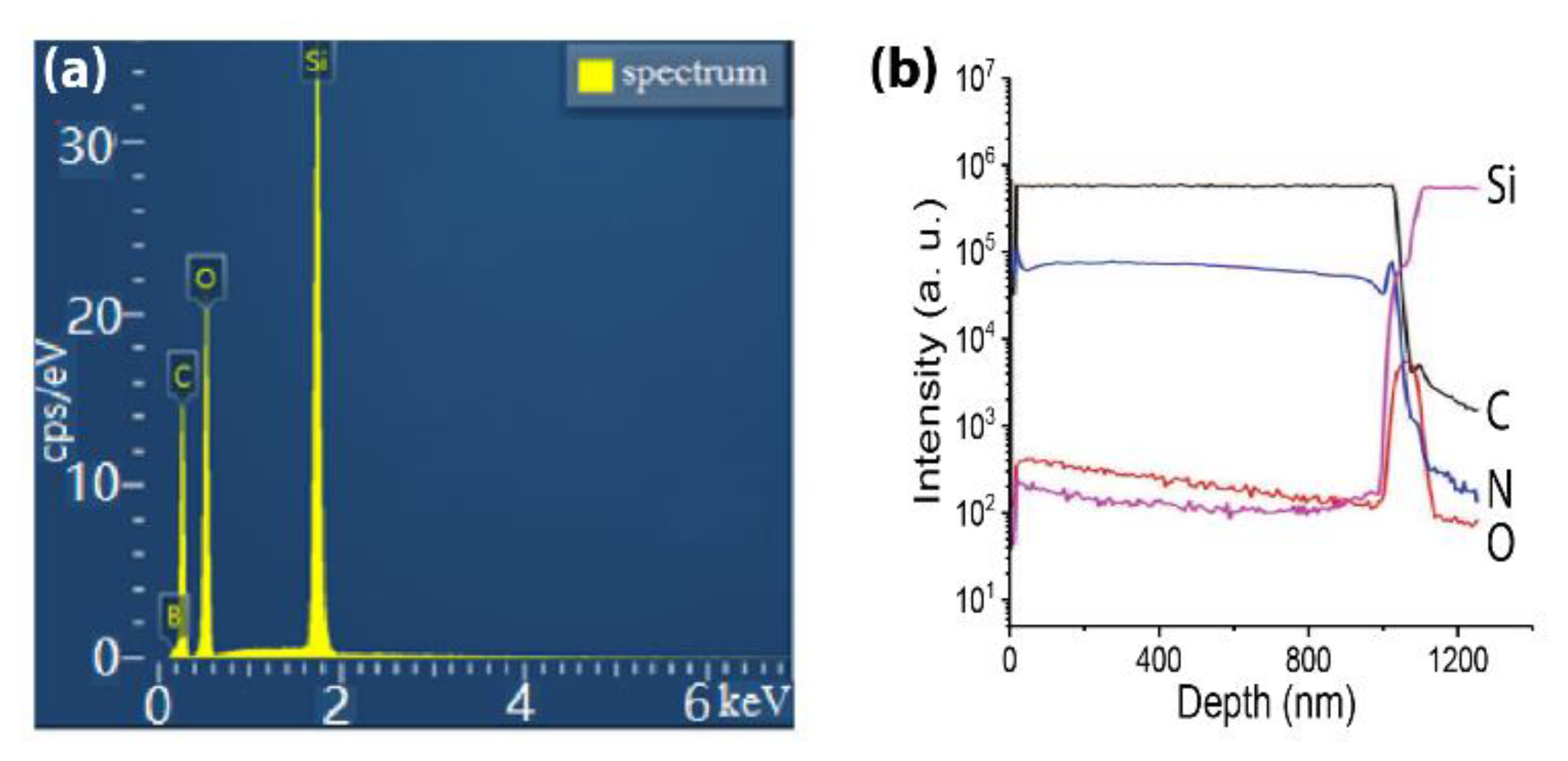


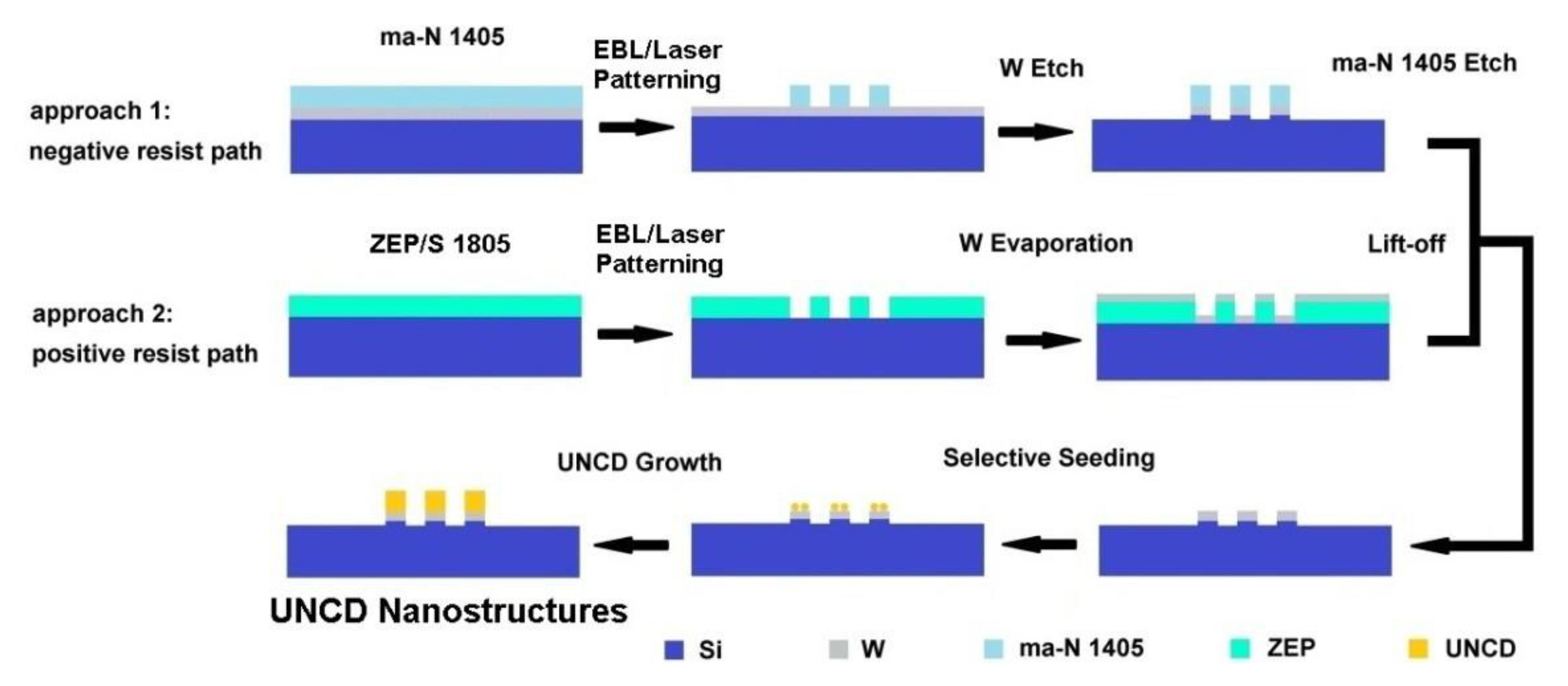

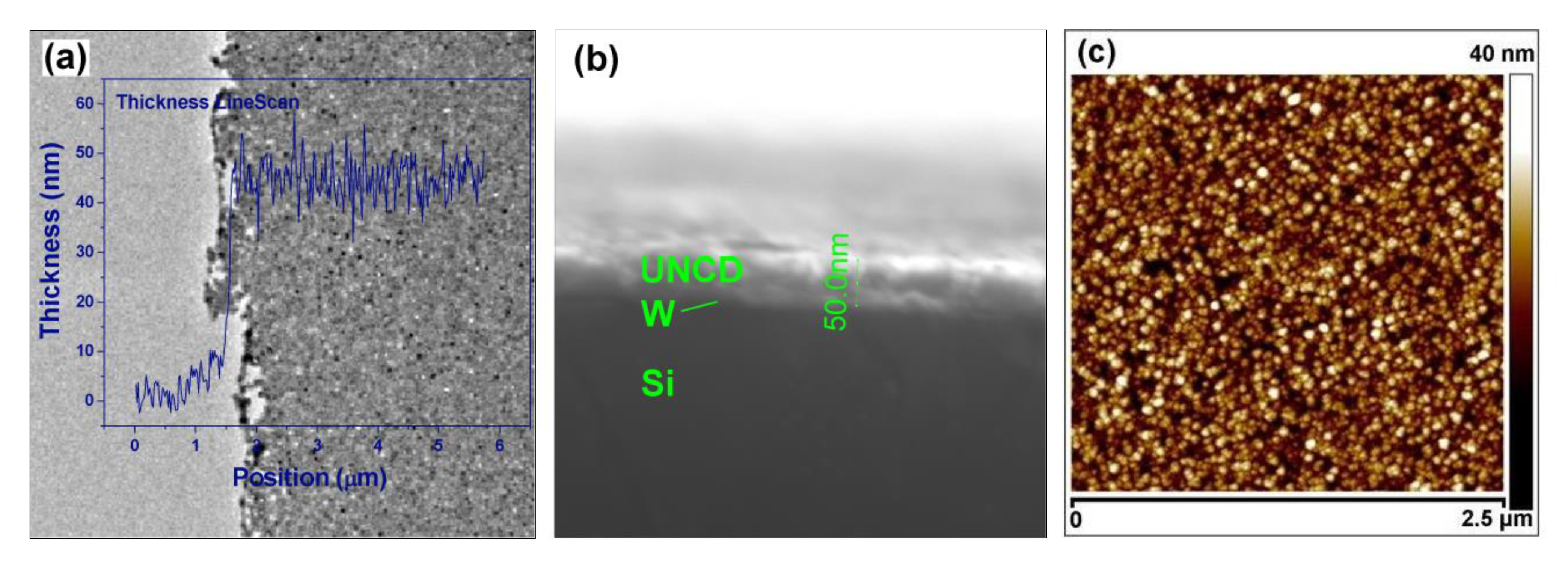

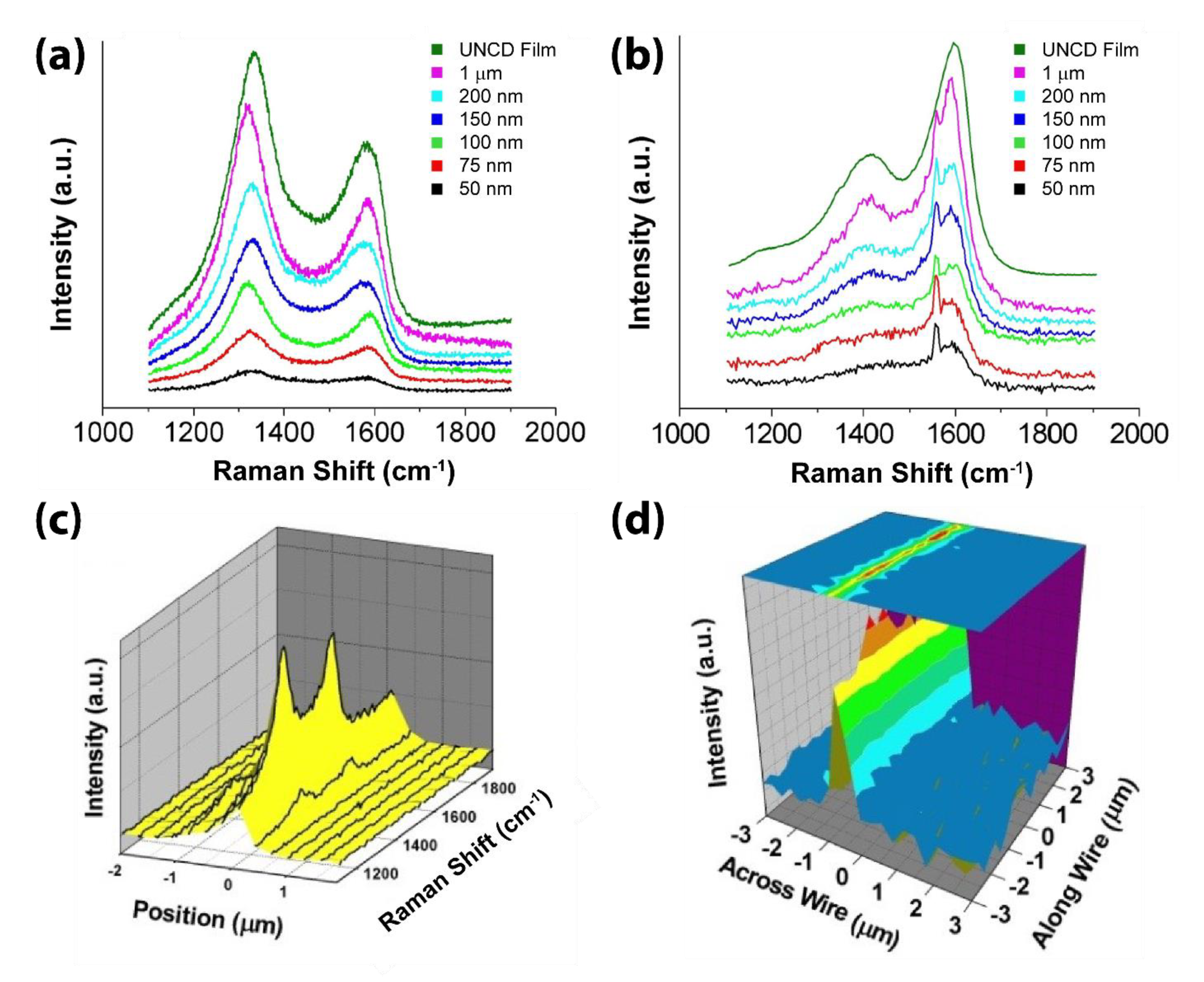
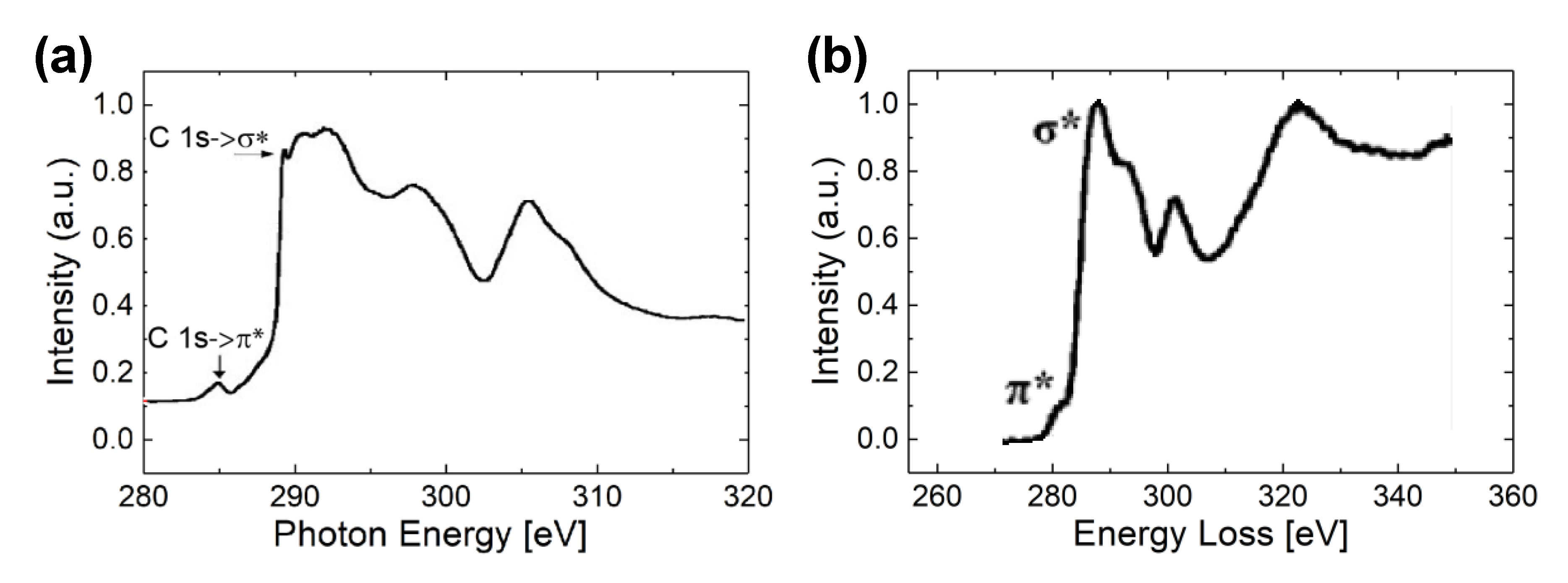
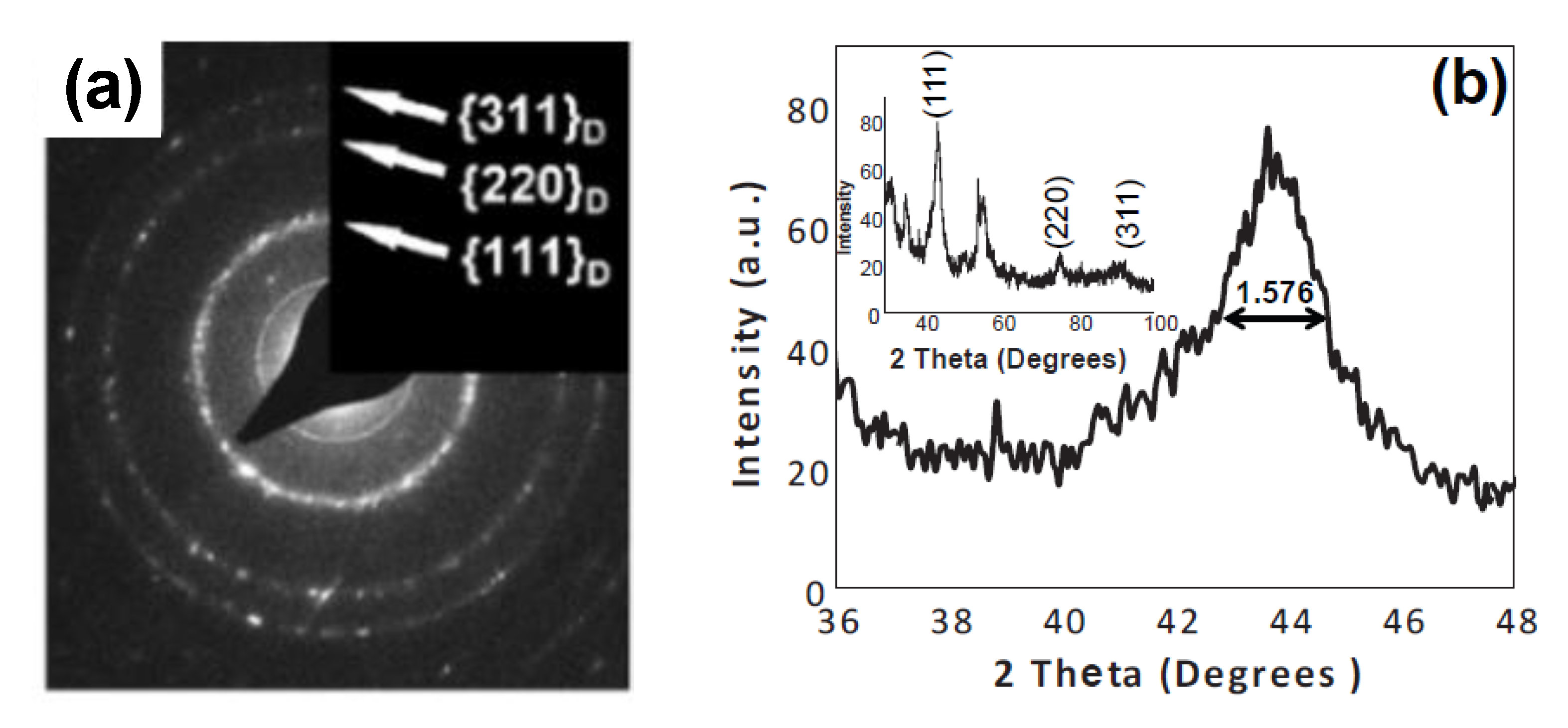

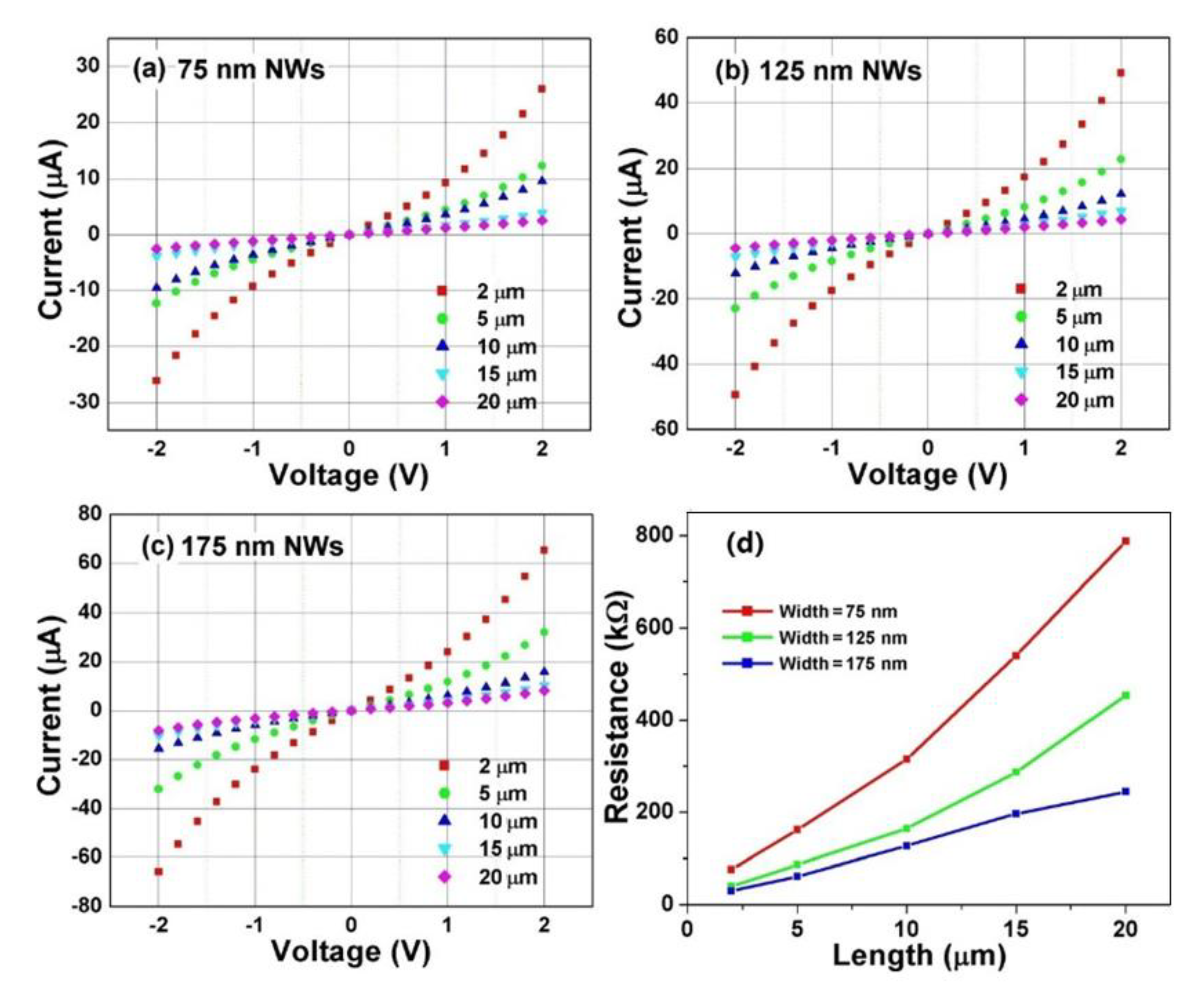

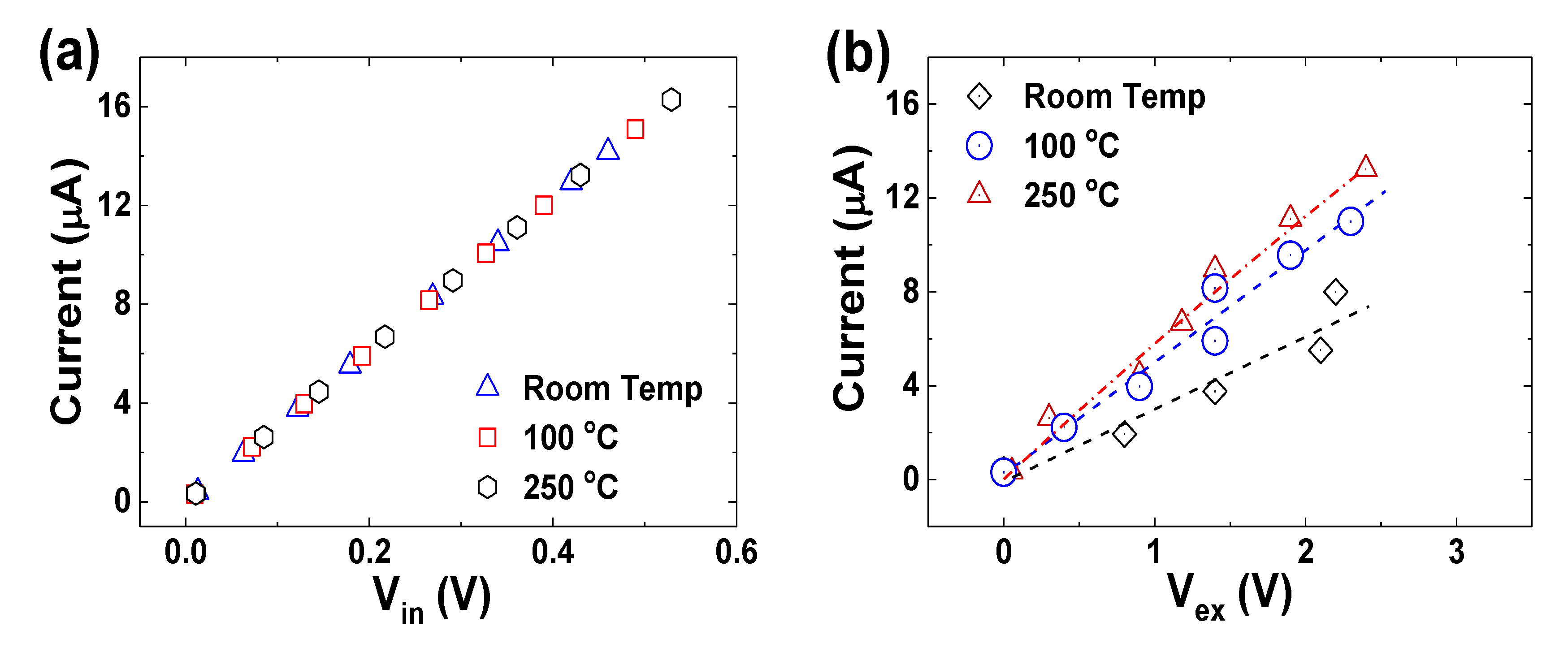



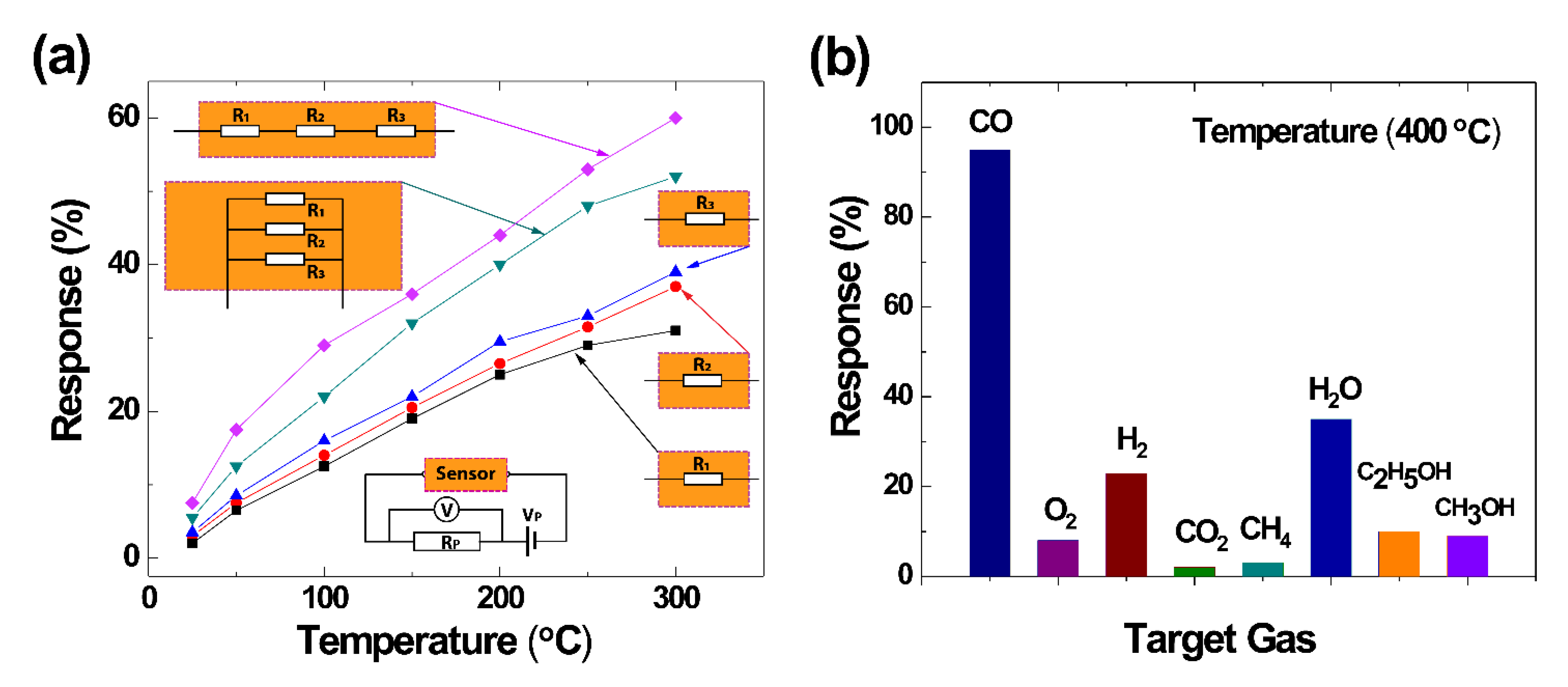

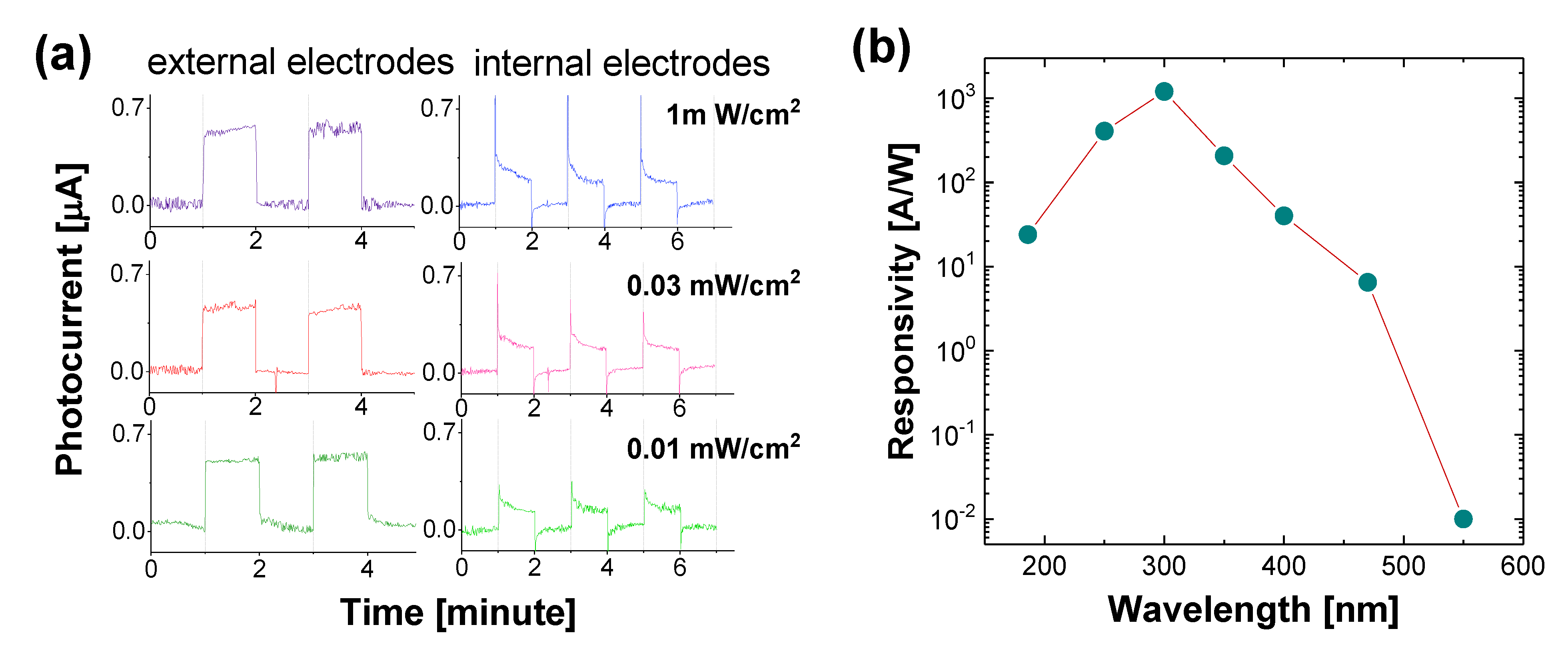



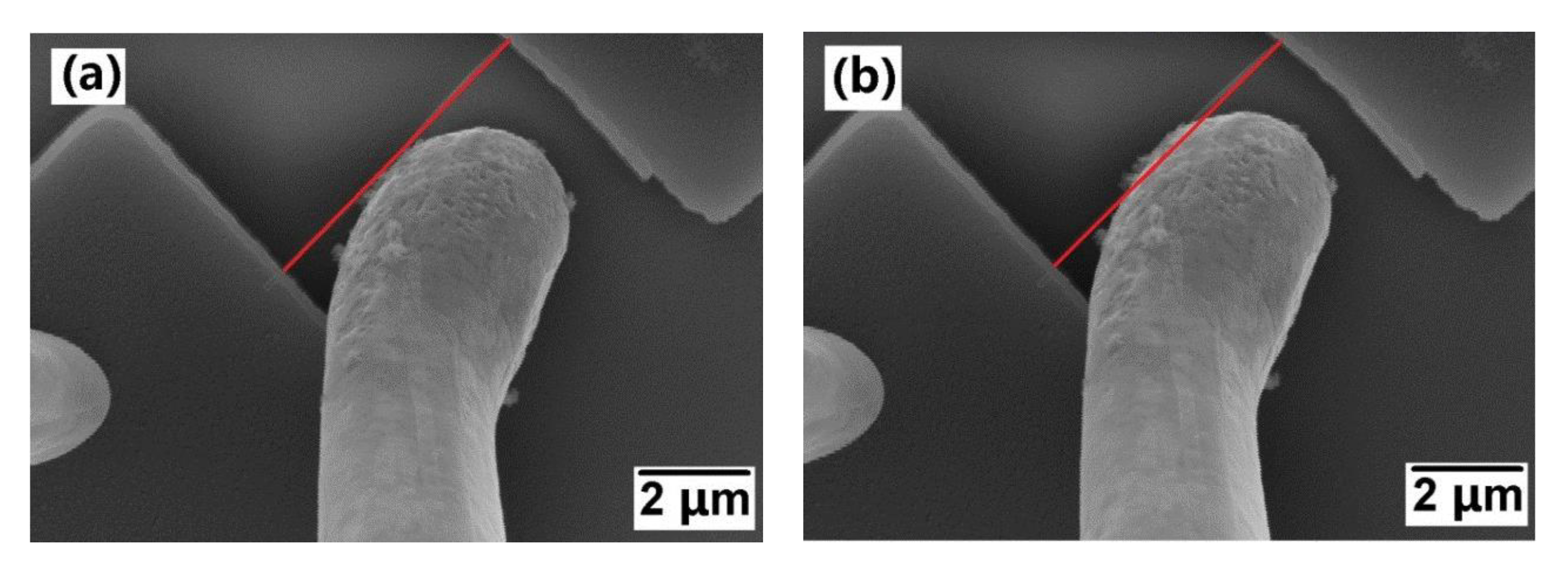
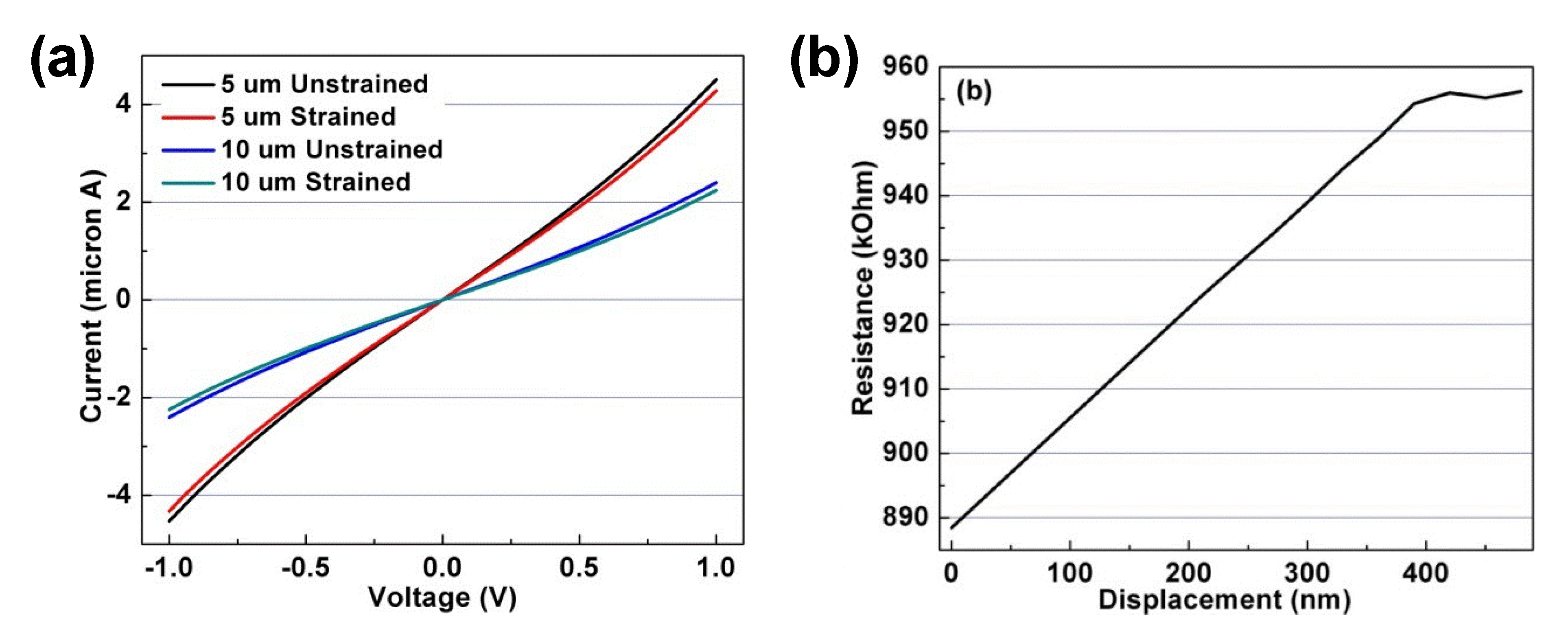

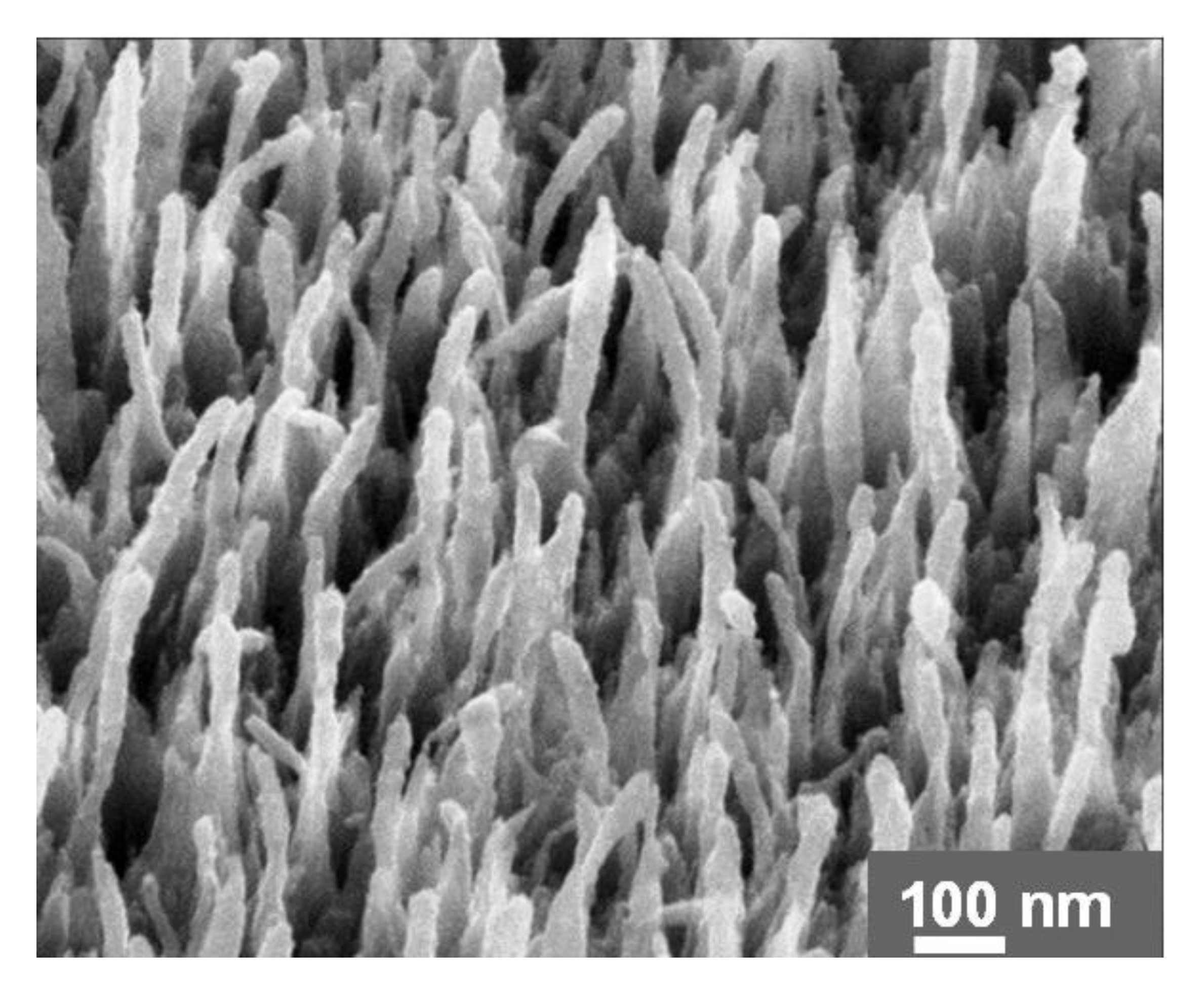

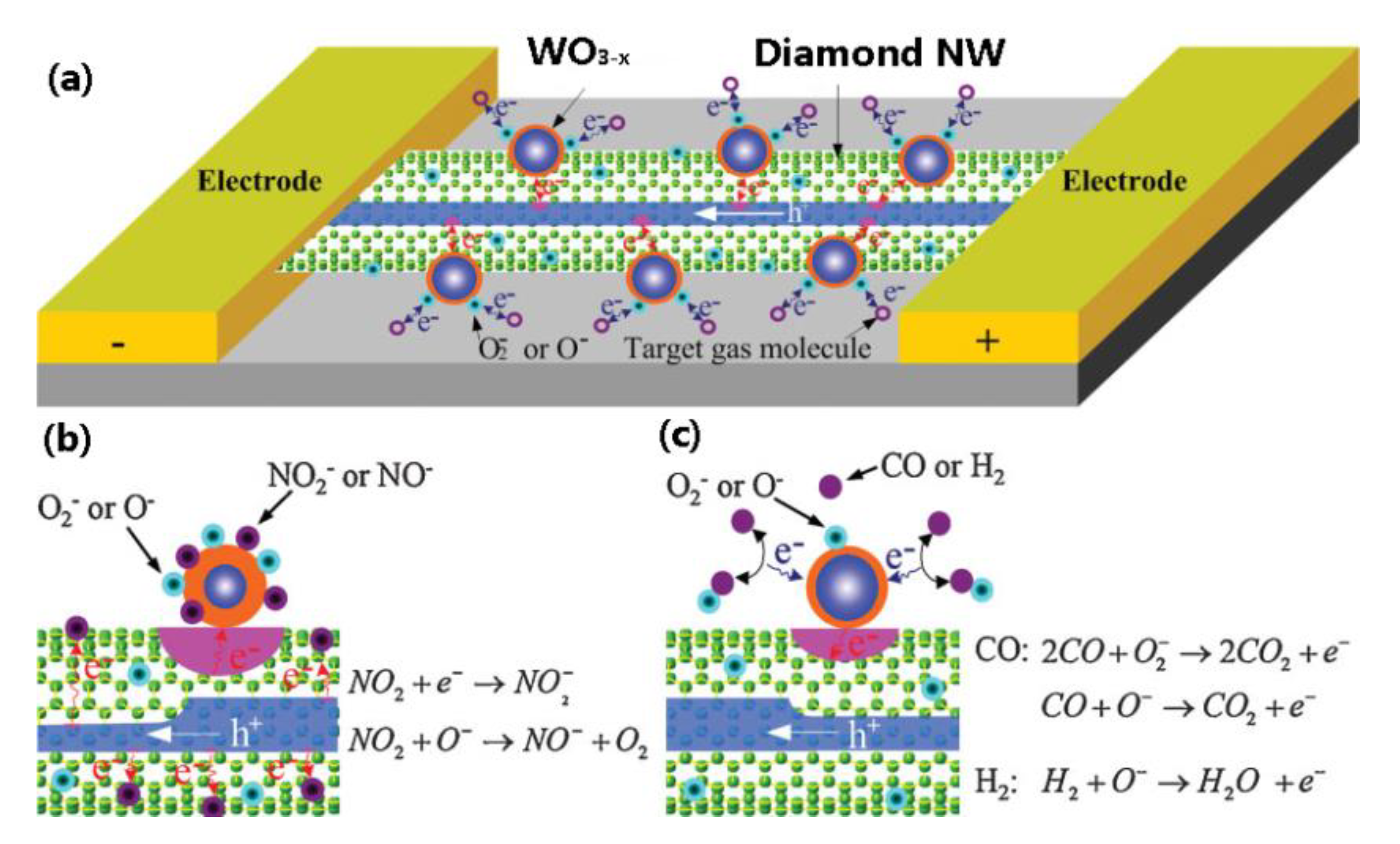
| Property | SCD | UNCD |
|---|---|---|
| Growth Chemistry | H2/CH4 | Ar/CH4 |
| Bonding Character | sp3 | 2–5% sp2 |
| Grain Size (undoped, nm) | 1–10,000 (depending on the sample size) | 3–5 |
| Grain Size (doped, nm) | - | 7–10 |
| Grain Boundary (undoped, nm) | - | ~0.4 |
| Grain Boundary (N-doped, nm) | - | 1–2 |
| Surface Roughness (nm) | - | 4–7 |
| Surface Uniformity (150-mm dia. Si Wafer) | ±5% | |
| Density (g/cm3) | 2.8–3.51 | 3.30 |
| Poisson Ratio | 0.1–0.16 | 0.057+/−0.038 |
| Young’s Modulus (GPa) | 820–900 | ~850 |
| Hardness (GPa) | 100 | 98 |
| Macroscopic Friction Coefficient in Air | 0.01–0.02 | 0.02–0.05 |
| Dielectric Constant | 5.6 | 5.68 |
| Mohs Hardness | 10 | 10 |
| Intrinsic Resistivity (Ohm-cm) | 1012–1016 | 103–104 |
| Material | Peak λ (nm) | Dark Current | UV/Visible | Responsivity (A/W) | Response Time | Reference |
|---|---|---|---|---|---|---|
| SCD film | 220 | (NEP ~ 0.5 pW) | 104 | 0.177 | - | [86] |
| SCD film | 210 | 1.1 pA | 104 | 0.048 | ~80 s | [97] |
| SCD film | 218 | 5 μA | 8.9 × 103 | 21.8 | - | [98] |
| B-SCD film | 210 | 10 μA | 106 | 230 | - | [99] |
| B-SCD film | 220 | ~1 μA | 2 × 106 | 1 | ~1 s | [100] |
| B-SCD film | 220 | - | 105 | 5.5 × 10−3 | 0.3 s | [81] |
| B-SCD film | 225 | 1 pA | 103 | 0.028 | - | [96] |
| SCD film | 190 | (S/N = 103) | 105 | 0.01 | 160 s | [80] |
| MCD film | 220 | 5 μA | - | 16.2 | ~20 min | [101] |
| S-MCD film § S-SMCD film § S-NCD film § | 220 | - | - | 0.01 | ~ms | [83] |
| PCD film | 200 | <0.1 nA | 106 | - | 150 ms | [89] |
| PCD film | 220 | <0.1 nA | >103 | 1.625 × 10−4 | - | [102] |
| NCD film | 365 | 0.2 mA | - | - | ~1 s | [90] |
| UNCD NW | 300 | 0.07 µA | 105 | 388 | 20 ms | [76] |
Publisher’s Note: MDPI stays neutral with regard to jurisdictional claims in published maps and institutional affiliations. |
© 2021 by the authors. Licensee MDPI, Basel, Switzerland. This article is an open access article distributed under the terms and conditions of the Creative Commons Attribution (CC BY) license (http://creativecommons.org/licenses/by/4.0/).
Share and Cite
Zhou, A.F.; Wang, X.; Pacheco, E.; Feng, P.X. Ultrananocrystalline Diamond Nanowires: Fabrication, Characterization, and Sensor Applications. Materials 2021, 14, 661. https://doi.org/10.3390/ma14030661
Zhou AF, Wang X, Pacheco E, Feng PX. Ultrananocrystalline Diamond Nanowires: Fabrication, Characterization, and Sensor Applications. Materials. 2021; 14(3):661. https://doi.org/10.3390/ma14030661
Chicago/Turabian StyleZhou, Andrew F., Xinpeng Wang, Elluz Pacheco, and Peter X. Feng. 2021. "Ultrananocrystalline Diamond Nanowires: Fabrication, Characterization, and Sensor Applications" Materials 14, no. 3: 661. https://doi.org/10.3390/ma14030661







